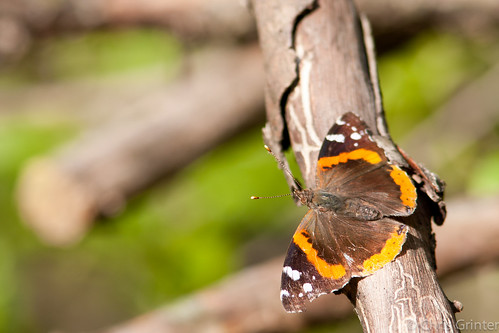Տեղական նորություններ մասը արեւելյան ԱՄՆ եւ Կանադա եղել aflutter (ունի) recently with reports of the irruption of Vanessa Ատալանտա – Կարմիր Ծովակալ Թիթեռներ. Թեեւ սա սովորական երեւույթ է: Ամեն գարնան այդ Թիթեռներ վերաբնակվելու հյուսիս իրենց overwintering հիմքերի հարավային ԱՄՆ, այս տարվա ահռելի թվերը ապշեցուցիչ են. Մեր բակերում բառացիորեն հազարավոր ծովակալներ կան.
Այսպիսով, ինչն է տարբերվում այս տարի?
Շատ են ենթադրությունները գարնանային տաք եղանակի մասին (Շատ վայրերում գրանցված ամենատաք մարտը) և հաճախ բազմաթիվ ապատեղեկատվություն՝ բազկաթոռի միջատաբանության հետ մեկտեղ. Լրատվական աղբյուրներից շատերը, որոնց ես հանդիպել եմ, ասում են, որ տաք գարունը թույլ է տվել այս թիթեռներին ծաղկել և բազմանալ աննորմալ քանակությամբ:. Այնուամենայնիվ, դա այնքան էլ հնարավոր չէ, Վ. atalanta overwinters as an adult. The southern states provide temps just warm enough for adult Vanessa butterflies to hide in the fall and be the very first to awaken in the spring to get a jump start on mating. Նույնիսկ եթե թիթեռները փետրվարին արթուն էին, հյուրընկալող բույսերը դեռ չէին հասունացել (տատասկափուշներ); մեր բակերի թիթեռները անցյալ տարվան են.
Բայց ինչ կլիներ, եթե եղանակն իրոք դեր խաղար այս բումի ցիկլի մեջ? Անցյալ տարի Լա Նինյա տարի էր մեր գեղեցիկ և մեղմ ձմեռով. Նախորդ տարի Էլ Նինյո էր, most of the eastern US was assaulted with winter and we suffered at the hands of the epic Chicago “snowpocalypse”. Թերևս այս համակցությունը բավականաչափ ճնշեց բնակչության թվաքանակը 2010/2011 որն այնուհետ նվազեցրեց պարազիտոիդային բեռը, թույլ տալով թիթեռների ընդհանուր պտղաբերությունը ամռանը 2011. Այնուհետև այդ ձմեռող թիթեռներին շնորհվեց տաք ձմեռ, որը կարող էր թույլ տալ ձմեռային մահացության ավելի ցածր մակարդակ. As the butterflies moved north this spring there were no frosty nights to cut into populations – just lots of hungry birds. Արդյունքը կլինի արտագաղթող թիթեռների աննորմալ հոսքը.
But then again…
Despite butterflies being so popular and well studied there doesn’t seem to be a perfect grip on what conditions each of the Vanessa species prefer. Ընդունող բույսերի փոփոխականները, բնակչության շրջանակը, եղանակը և պարազիտոիդները բոլորն էլ կարևոր դեր են խաղում առատության և տարածման մեջ. Did the weather cycles of the last few years variably effect one species over another? Ով է ուզում այդ PhD նախագիծը (Դժոխքից)?
One of the best posts I’ve read is by Doug Taron over on Թեթեվ գոբելեն – he is skeptical of this warm weather theory. Critically this irruption is effecting only the population of the Red Admiral and any theory involving weather would also likely effect other migrant butterflies like the Vanessa virginiensis – the American Lady. He also points out that an abundant butterfly like the admiral has classic cyclical population booms and busts in sync with parasite populations. I recall another summer in the late 90’s of staggering Admiral populations. Parasites really do better explain what we see in our yards this spring. While the weather might not have caused the abundance of Վ. atalanta, there can be no denying that butterflies of all species have woken up much earlier this year.



As far as I recall, almost all temperate zone animals (and plants, Ես կասկածում եմ,) go thru boom and bust cycles. It’s pretty much the function/nature of the wildly variable environmental conditions of the ecosystems. Even the less common temperate zone species cycle but the effects are less noticed simply because of the lower population levels.
must have been a lovely sight, vanessa atlanta has been struggling in the UK for the past few years!!
A few years back you may have heard about the painted lady invasion in the UK very much the same as the USA i was counting well over 1000 an hour coming up the field from the english channel !
Quick question about la nina i believe the later part of 2010 was also la nina thats why the UK and northern USA had such cold weather